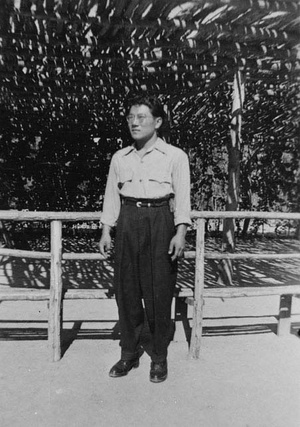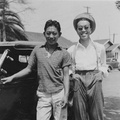Read part 1 >>
The WRA worked hard to weed out yogore among potential resettlers. Prisoners who wanted to leave the camps had to promise federal officials that they would only speak English in public, avoid associating with large groups of Japanese, and generally conform to mainline standards of behavior and clothing.

Junichi “Frisco” Yamasaki—posing in drapes, Poston, Arizona, concentration camp, 1942. Gift of Frisco Yamasaki, Japanese American National Museum [2000.415.1]
Chicago’s resettlers tested this rigid vision of ethnic dispersal right away. Some complied strictly with the WRA’s guidelines. But others took a more realistic approach in this new, strange city. Lonely Nisei sought each other out for companionship. Many hesitated to interact with whites because they simply did not know where they stood in Chicago’s racial order. Racial discrimination also intensified their uneasiness and remained a barrier to securing desirable housing, employment, and access to public spaces such as dance halls, hospitals, and even cemeteries.
Living an indeterminate present and looking toward an unknown future, countless resettlers readily dismissed the WRA’s instructions to act as respectable “ambassadors” to mainstream America. Many quit their jobs unannounced, seeking better work and higher pay, to the chagrin of federal authorities who feared that such habits “reflected unfavorably” on all Japanese Americans.
Some zoot suiters openly flaunted the government’s assimilationist directives. Tadashi “Blackie” Nakajima not only continued to wear his drapes around Chicago, but also spewed English vulgarities and Japanese slang expressions in public, consorted with the North Clark Street yogore gang, gambled, and frequented brothels—clearly not the type of integration that the WRA had in mind for former internees.
Sus Kaminaka’s wartime testimony captured this pervasive feeling of restlessness and anxiety. After going through a series of jobs in Chicago, he concluded that he would “play around” until being drafted, filling his days and nights with Nisei dances, drinking, and sexual exploits. Kaminaka expressed a profound ambivalence toward this existence: “I am getting absolutely no place now… It isn’t doing me much good. It bothers me a lot and I think [about] a lot of things I should be doing but I never get ambitious enough to get around to it.”
Yet he also admitted to feeling hopeful, confessing a yearning to be recognized as a bona fide American. “I am willing to fight for the US as I plan to live here always and it is my country in spite of what some Caucasians say. At least I can say that I have a more definite part in the war effort if I were drafted. That’s about all the future I can look forward to now.” In the meantime, however, Kaminaka and scores of other resettlers—yogore and “non-yogore” alike—continued to drift, finding solace in the very types of activities discouraged by the state.
Predictably, the Nisei’s unseemly conduct unsettled resettlement coordinators. Fearing that the situation would only worsen, a group of Nikkei and their allies established the Chicago Resettlers Committee (CRC) in September 1945 “to attend to the unfinished problems of evacuation and resettlement.” CRC co-founder Setsuko Matsunaga Nishi detailed resettlers’ anomalous predicament: bereft of the “stabilizing factors of family and community ties,” Nisei harbored a “sense of futility about their future, a feeling of not belonging, of being outcast.” To underscore the direness of the situation, Nishi pointed to the yogore: “the Nisei with ‘Zoot Suit’ and pachuco duck-tail hair cut is not an uncommon sight,” she warned.
The CRC argued that the formal organization of the Japanese American community was increasingly urgent as Nikkei continued to stream into the city. Resettlers needed assistance to restart their lives and constructive recreational activities to redirect Nisei from the “unwholesome influences” that were already tempting them.
While CRC leaders agreed with the WRA that the “ultimate goal” of resettlement was assimilation, they proposed a radically different approach. By creating a stable, nurturing social environment, activities that specifically targeted Japanese Americans could still be used to achieve integration. Furthermore, they stressed that mainstream institutions—rather than Nikkei themselves—bore the burden of responsibility for this task.
The CRC’s arguments sufficiently persuaded the WRA to reevaluate its original vision for resettlement. Chicago’s Council of Social Agencies, the umbrella organization of municipal social services, officially recognized the CRC in September 1946 and agreed to provide half of its operating budget for 1947. Soon Chicago would boast of a vibrant, postwar Japanese American community anchored by the CRC and more than 100 other ethnic associations.
Zoot suiters, then, played an important role in the formation of Nikkei community in Chicago. As individuals, they forced the WRA and its partners to reconsider their strict assimilationist blueprint for resettlement. And as symbolic figures, they provided a powerful rhetorical specter that Japanese American spokespersons skillfully invoked to legitimate the establishment of ethnic organizations.
Yet Nisei zoot suiters have remained forgotten in Japanese American history and American history more generally. How do we explain this curious absence? For one, Japanese American spokespersons ensured that the public face of the ethnic community during and after the war was “GI Joe Nisei.” The Japanese American Citizens League (JACL) worked especially hard to publicize Nisei battlefront contributions. It spotlighted the phenomenal record of the 100th/442nd Regimental Combat Team and other Nisei in uniform as way to emphasize Japanese Americans’ undivided loyalty to the nation. Such a project, of course, was critical to the possibility of a collective future for Japanese Americans in the United States. But as narratives of Nikkei martial heroism gained widespread traction, they crowded out other images of Japanese Americans—including yogore—obscuring these stories for decades.
In the end, however, the actions and thoughts of those who were identified as yogore or pachuke were arguably not so different than other Nisei. It is important to remember that many (if not most) of Chicago’s resettlers ignored or flouted the federal government’s insistence that they stay away from their fellow Japanese Americans, steer clear of anything “Japanesey,” and fade into the white middle-class. Ultimately, affirming this diversity of experiences allows for a fuller understanding of Japanese American history and the range of the very human consequences of racial profiling and wartime incarceration.
Note on Sources:
The best primary sources on Japanese American zoot suiters are the life history interviews of Nisei resettlers in Chicago recorded by Charles Kikuchi during World War II. Kikuchi was part of the University of California’s Japanese American Evacuation and Resettlement Study (JERS), a team of white and Nisei social science investigators who conducted extensive fieldwork on the wartime incarceration experience as it unfolded. The verbatim transcripts of Kikuchi’s interviews, along with his field notes and diary entries, are available at the University of California, Berkeley’s Bancroft Library Special Collections and the University of California, Los Angeles’s Young Research Library Special Collections. Fifteen of the 64 interviews were published in abridged form in Dorothy Thomas, The Salvage (University of California Press, 1952), including that of Sus Kaminaka. (Note that “Sus Kaminaka” was the pseudonym that Kikuchi assigned to subject “CH-45, agricultural student.”)
Other sources consulted for this essay include various concentration camp newspapers (available on densho.org), the Japanese Relocation Collection at the Church of the Brethren Archives (Elgin, IL), the Chicago Resettlers Collection at the Chicago History Museum Research Collection, and the Japanese American Service Committee Legacy Center Archives (Chicago). For full citations see Chapter 1 in Ellen D. Wu, The Color of Success: Asian Americans and the Origins of the Model Minority (Princeton, 2014).
* This article was originally published on Nikkei Chicago on January 25, 2014.
© 2014 Ellen D. Wu



